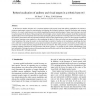Free Online Productivity Tools
i2Speak
i2Symbol
i2OCR
iTex2Img
iWeb2Print
iWeb2Shot
i2Type
iPdf2Split
iPdf2Merge
i2Bopomofo
i2Arabic
i2Style
i2Image
i2PDF
iLatex2Rtf
Sci2ools
RAS
2000
2000
Robust localization of auditory and visual targets in a robotic barn owl
In the last two decades, the barn owl, a nocturnal predator with accurate visual and auditory capabilities, has become a common experimental system for neuroscientists investigating the biological substrate of spatial localization and orienting behavior. As a result, much data are now available regarding the anatomy and physiology of many neural structures involved in such processes. On the basis of this growing body of knowledge, we have recently built a computer model that incorporates detailed replicas of several important neural structures participating in the production of orienting behavior. In order to expose this model to sensorimotor and environmental conditions similar to those experienced by a barn owl, the computer simulations of the neural structures were coupled to a robot emulating the head of a barn owl, which was presented with auditory and visual stimulation. By using this system we have performed a number of studies on the mechanisms underlying the barn owl's c...
| Added | 19 Dec 2010 |
| Updated | 19 Dec 2010 |
| Type | Journal |
| Year | 2000 |
| Where | RAS |
| Authors | Michele Rucci, Jonathan Wray, Gerald M. Edelman |
Comments (0)

